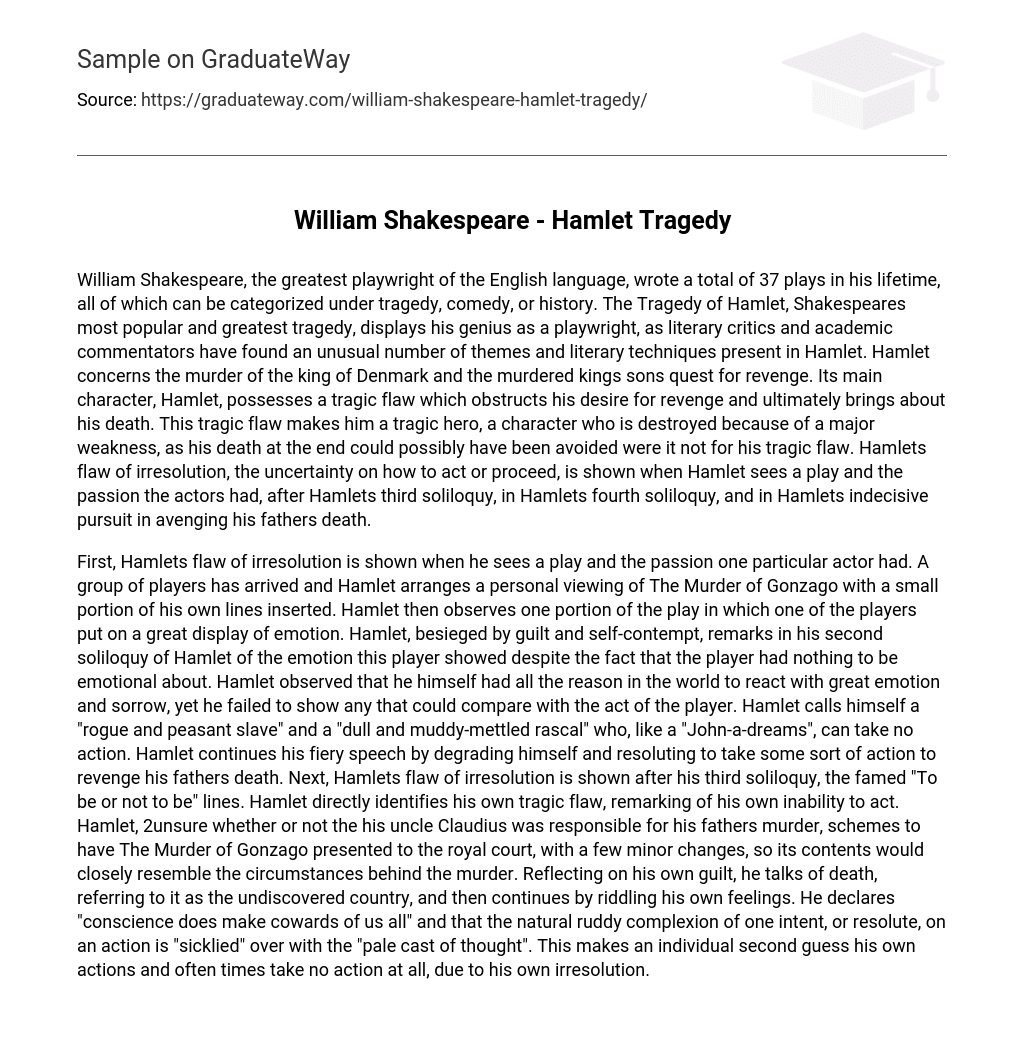William Shakespeare, the greatest playwright of the English language, authored 37 plays throughout his lifetime. All of his works can be classified as tragedy, comedy, or history. The Tragedy of Hamlet stands out as Shakespeare’s most celebrated and supreme tragedy, illustrating his genius as a playwright. Scholars and critics have identified numerous themes and literary techniques in Hamlet. This play revolves around the assassination of the Danish king and his son’s quest for retribution. The protagonist, Hamlet, possesses a tragic flaw that obstructs his desire for vengeance and ultimately leads to his downfall. This fatal flaw characterizes him as a tragic hero – someone whose ruin stems from a significant weakness. Were it not for this flaw, Hamlet’s demise could potentially have been prevented. His flaw becomes apparent through his hesitancy demonstrated when he witnesses an impassioned performance, during both his third and fourth soliloquies, and in his uncertain pursuit of avenging his father’s death.
The flaw of irresolution in Hamlet is illustrated twice. First, when he witnesses a passion-filled performance by an actor during a personal viewing of The Murder of Gonzago. Despite feeling guilty and contemptuous of himself, Hamlet acknowledges the actor’s ability to display emotion even without reason. Hamlet criticizes his own lack of emotional reaction, calling himself names and expressing his determination to seek revenge for his father’s death.
Later, after delivering the famous “To be or not to be” lines in his third soliloquy, Hamlet again reflects on his tragic flaw. He admits his hesitation to take action, unsure if his uncle Claudius is truly responsible for his father’s murder. To further investigate, Hamlet plans to modify The Murder of Gonzago to closely mirror the circumstances of the crime and present it to the royal court.Reflecting on his guilt, the speaker discusses death, referring to it as the undiscovered country. He then continues by questioning his own feelings. He asserts that conscience makes us cowardly and that a resolute person’s natural complexion is tainted with hesitation. This leads individuals to doubt their own actions and often choose inaction due to their indecisiveness. These statements not only apply to past events but also foreshadow future occurrences.
Next, during his fourth soliloquy, Hamlet’s flaw of irresolution is revealed. The Prince of Norway, Fortinbras, and his army have just passed by Hamlet and his escorts. Hamlet observes Fortinbras’ actions in fighting and reflects on his efforts and bravery, hoping to revive his own desire for revenge against Claudius for his father’s death. Hamlet acknowledges that everything around him urges him to seek revenge, but he fails to act. He realizes that he overthinks the situation and admits that he has both the motive and the means to seek revenge, as the evidence against Claudius as his father’s killer is clear. Ultimately, Hamlet decides that his thoughts must either be filled with bloodshed or they are worthless. He has finally resolved to take some form of action against Claudius.
The text describes how Hamlet’s inability to make decisions hinders his quest for revenge. Despite having multiple opportunities to kill Claudius, Hamlet always finds excuses to not take action. When Hamlet first learns about his father’s murder from the ghost, he immediately wants to seek vengeance. However, he starts doubting the ghost’s intentions and worries that the devil may be manipulating him into killing an innocent man, which would damn his soul. To determine Claudius’s guilt, Hamlet devises a plan involving a play. As Claudius becomes visibly uncomfortable during the performance and abruptly leaves, Hamlet is convinced of his guilt and prepares to avenge his father once again. When Hamlet finds Claudius alone and vulnerable while he is praying, he contemplates how killing him at that moment would result in Claudius’s sins being forgiven, which conflicts with his desire to damn Claudius’s soul. Therefore, Hamlet decides to postpone the act. Throughout these events, Claudius becomes aware that Hamlet is aware of his crime and schemes to have him killed by sending him to England and arranging his murder. However, Hamlet manages to evade this plan, prompting Claudius to come up with another scheme: assassinating Hamlet during a fencing match. Despite being wounded with a poisoned foil, Hamlet manages to kill Claudius before succumbing to his own injuries.The flaw of irresolution in Hamlet proved to be his downfall, as his inability to take action in past situations ultimately resulted in his demise.
The play “Hamlet” effectively portrays Hamlet’s indecisiveness through his actions after watching the actors’ performance, his third soliloquy, his fourth soliloquy, and his hesitant pursuit of revenge for his father’s murder. Although Hamlet eventually manages to avenge his father’s death, his tragic demise due to his inability to make decisions clearly identifies him as the main character. The play illustrates how the failure to act decisively, regardless of noble intentions, can have negative consequences on an individual’s personality.
Bibliography:





